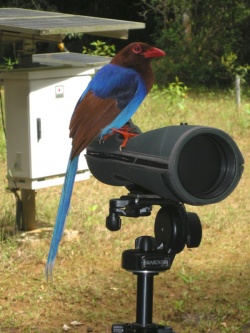m |
|||
| Line 18: | Line 18: | ||
==Other Wildlife== | ==Other Wildlife== | ||
| − | ' | + | The endemic Purple-faced Langur and Toque Macaque are easily seen here. Dusky Palm Squirrel and Layard's Palm Squirrel are also possible, sometimes in bird waves. Giant Squirrel can also be seen. <br /> |
| + | Other mammals occur but are difficult to see. These include Sambar, Leopard, Indian Pangolin and Slender Loris. | ||
==Site Information== | ==Site Information== | ||
| Line 30: | Line 31: | ||
===Access and Facilities=== | ===Access and Facilities=== | ||
| − | ' | + | Most birders stay in or near Kudawa, at the northwestern edge of the reserve. The famous Martin's Lodge and the Blue Magpie Lodge are found there. Some other places also offer basic accomodation. As the accomodation is limited it is recommended to book in advance. Kudawa can be reached by car from Rakwana or Kalawana. Busses also serve the village, however you will need some time to get there on public transport.<br /> |
| + | Some small shops are found near the busstop. From Kudawa you need about 30 minutes to the Ticket office (some lodges drive you there). There you have to pay the entry permit and you have to take a guide. Entry is around 650 rupees, the guide around 1500. You can then walk with the guide to the Kalawana research station, passing through wonderful forest. Ask for a guide who knows the birds, some are really good and do know the songs as well.<br /> | ||
| + | The reserve can also be explored from the village of Kosmulla or from Deniyaya. The latter has many hotels and lodges, however, it's a long way to reach the forest and the habitat is more degraded than around Kudawa. | ||
[[Category:Sri Lanka]] [[Category:Locations]] | [[Category:Sri Lanka]] [[Category:Locations]] | ||
Revision as of 08:52, 15 February 2013
| This article is incomplete. This article is missing one or more sections. You can help the BirdForum Opus by expanding it. |
Overview
Sinharaja Forest Reserve in the southwest of Sri Lanka is the last significant relict of rainforest in the wet zone of Sri Lanka. It's a national park and it has been declared a Biosphere Reserve and World Heritage Site by UNESCO. Sinharaja means Kingdom of the Lion.
The forest holds most of the endemic birds of Sri Lanka and should be included on every birding trip to this island.
Birds
Notable Species
to do
Rarities
to do
Check-list
Birds you can see here include:
Sri Lanka Spurfowl, Sri Lanka Junglefowl, Jerdon's Baza, Black Eagle, Oriental Honey-buzzard, Crested Serpent Eagle, Crested Goshawk, Shikra, Besra, Crested Hawk Eagle, Legge's Hawk Eagle, Green Imperial Pigeon, Spotted Dove, Sri Lanka Green Pigeon, Emerald Dove, Sri Lanka Hanging Parrot, Layard's Parakeet, Indian Cuckoo, Red-faced Malkoha, Greater Coucal, Green-billed Coucal, Sri Lanka Bay Owl, Serendib Scops Owl, Chestnut-backed Owlet, Sri Lanka Frogmouth, Indian Swiftlet, Asian Palm Swift, Brown-backed Needletail, Crested Treeswift, Malabar Trogon, Dollarbird, White-throated Kingfisher, Oriental Dwarf Kingfisher, Common Kingfisher, Blue-tailed Bee-eater, Sri Lanka Grey Hornbill, Yellow-fronted Barbet, Crimson-fronted Barbet, Lesser Yellownape, Crimson-backed Goldenback, Indian Pitta, Ashy Woodswallow, Bar-winged Flycatcher-Shrike, Orange Minivet, Brown Shrike, Sri Lanka Drongo, White-bellied Drongo, Black-hooded Oriole, Asian Paradise-Flycatcher, Black-naped Monarch, Sri Lanka Blue Magpie, Indian Jungle Crow, Great Tit, Sri Lanka Swallow, Black-capped Bulbul, Red-vented Bulbul, White-browed Bulbul, Yellow-browed Bulbul, Square-tailed Bulbul, Common Tailorbird, Green Warbler, Brown-capped Babbler, Dark-fronted Babbler, Sri Lanka Scimitar Babbler, Orange-billed Babbler, Yellow-billed Babbler, Ashy-headed Laughingthrush, Oriental White-eye, Velvet-fronted Nuthatch, Sri Lanka Hill Myna, Lesser Hill Myna, White-faced Starling, Spot-winged Thrush, Sri Lanka Thrush, Oriental Magpie Robin, Brown-breasted Flycatcher, Tickell's Blue Flycatcher, Jerdon's Leafbird, Pale-billed Flowerpecker, Legge's Flowerpecker, Purple-rumped Sunbird, Loten's Sunbird, White-rumped Munia, Scaly-breasted Munia
Other Wildlife
The endemic Purple-faced Langur and Toque Macaque are easily seen here. Dusky Palm Squirrel and Layard's Palm Squirrel are also possible, sometimes in bird waves. Giant Squirrel can also be seen.
Other mammals occur but are difficult to see. These include Sambar, Leopard, Indian Pangolin and Slender Loris.
Site Information
to do
History and Use
to do
Areas of Interest
to do
Access and Facilities
Most birders stay in or near Kudawa, at the northwestern edge of the reserve. The famous Martin's Lodge and the Blue Magpie Lodge are found there. Some other places also offer basic accomodation. As the accomodation is limited it is recommended to book in advance. Kudawa can be reached by car from Rakwana or Kalawana. Busses also serve the village, however you will need some time to get there on public transport.
Some small shops are found near the busstop. From Kudawa you need about 30 minutes to the Ticket office (some lodges drive you there). There you have to pay the entry permit and you have to take a guide. Entry is around 650 rupees, the guide around 1500. You can then walk with the guide to the Kalawana research station, passing through wonderful forest. Ask for a guide who knows the birds, some are really good and do know the songs as well.
The reserve can also be explored from the village of Kosmulla or from Deniyaya. The latter has many hotels and lodges, however, it's a long way to reach the forest and the habitat is more degraded than around Kudawa.






